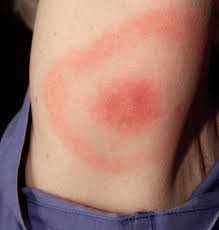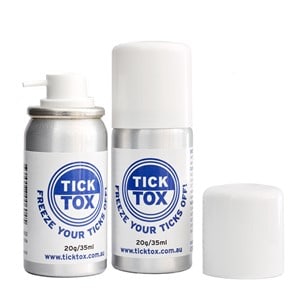TICKS REMOVAL BITE TREATMENT SYMPTOMS AND PREVENTION
THE FULL STORY
Get prepared for Tick Season
With the release of a new Australian Product called Tick Tox, it freezes ticks off, we thought it was timely to review currrent treatment for Tick bites in Australia. Living on the coast of Australia I am sure most of us have had a tick at some stage. Maybe on or maybe you have removed them from friends, family or your pets. How hard are the annoying little blood suckers are to remove?
There are more than 800 species of ticks around the world, with 70 found in Australia and 16 species have been reported as feeding on humans. Feeding! Does that make your skin crawl? Amazingly an Australian study reported that 34 out of 500 people presenting to a Sydney hospital, for tick removal, were suffering from anaphylaxis. If you suffer from anaphylaxis you should carry and Epi-pen.
Interestingly, Australian native animals are resistant to paralysis ticks.

Paralysis Tick distribution map
Paralysis ticks are found along the east coast of Australia in a 20km wide band and are responsible for killing hundreds of our pets every year.
Signs and Symptoms of tick paralysis bites in humans
Some symptoms you might notice are
- Rashes,
- Headaches
- Fever
- Body aches
- Being unsteady on your feet
- Weakness in your limbs
- Facial paralysis
How do you remove a tick safely?
Tick removal, so what is the best way to get them out? There are many myths and stories about how to safely remove a tick. There are many myths and substances talked about anecdotally as being the best to kill them and then let them remove themselves. The problem with many of these ‘urban myths’ is that they only serve to irritate the tick which causes the tick to inject more of its saliva. It is the Saliva that causes us the irritation.
Are tick bites Dangerous?
Yes, they can be. NSW Health recommends those who have a history of allergic reactions should go to a doctor with resuscitation facilities to have it removed. They also recommend avoiding applying such things as methylated spirits or heating the tick to encourage it to detach.
The most effective way to completely remove a tick without irritating it is…..
Freezing the tick with a product like Tick Tox right where it is, not touching it with hands or tweezers to irritate it.
The Australasian Society of clinical Immunology and Allergy recommends using a product that will rapidly freeze the tick leave it for a minute and then brush the frozen tick off. This means there is no risk of squeezing the tick or irritating it prior to its death.
Tick freezing sprays have been passed by the TGA for use on animals and Humans. Sprays like Tick Tox, which freezes and kills the tick making it simple to remove are widely available for purchase online from your local supplier.
In a recent interview Dr Andrew Ratchford, Director of Emergency Mona Vale District Hospital, was talking about mammalian meat allergy, and that there may be some association with how the ticks were removed. He stated that the best way to remove ticks is by freezing them where they are, with the goal to not irritate the tick into releasing more saliva into the bite site.
More evidence to suggest that freezing the tick off is the best way of removal can be found in JAMA dermatological with an account of a Dr freezing a tick off in France, 2013, describing it as effective, painless, non-invasive, safe and rapid.
Smaller ticks, though such as those at the larval and nymph stage can be treated with a product called Lyclear which is available over the counter at any pharmacy. The cream is dabbed on to the tick not rubbed in. After an hour the larvae or nymphs can be scrapped off the skin.
First Aid for tick bites
Paralysis ticks are present all year round here in Australia, but the peak season is spring and summer, when our warm weather combines with rain to produce an ideal climate for ticks.
The Australian Resuscitation Council Guidelines for the first aid treatment of tick bites includes
- If the person is unresponsive and not breathing normally, commence CPR
- If the person is having trouble breathing, has swelling of the face or mouth, difficulty speaking treat for anaphylaxis
- If the person has a history of tick allergy, the tick must be killed where it is, rather than removed
- If in a remote location, consultation with healthcare professionals is recommended
- Move person to a safe place
- Apply a cold compress to help reduce pain and swelling

To prevent tick bites
Prevention is better than cure when it comes to tick bites and the easiest tick to remove is the one that didn’t get the chance to bite you. To reduce your risk with ticks you should
- Wear light coloured clothing, this makes ticks easier to detect or see
- Avoid walking through dense bush and vegetation, stick to the centre of tracks
- Tuck your pants into your socks and shirts into pants to prevent the ticks away from your skin
- Did you know that you can use insect repellent containing at least 20 per cent DEET. Apply the Insect repellent to the skin when you know you are entering tick infested areas as it can protect you from ticks for several hours.
Remember those who have a history of allergic reactions should present to a doctor with resuscitation facilities to have it removed.
References:
https://www.youtube.com/watch?v=PPVANB2dwV0 published Jul 25 2017 Accessed 23/08/2018
https://www.health.nsw.gov.au/environment/pests/parasites/Pages/ticks.aspx accessed 23/08/2018
www.health.nsw.gov.au March 2013 accessed 23/08/2018
https://www.healthdirect.gov.au/tick-bites
https://jamanetwork.com/journals/jamadermatology/article-abstract/1688071 Acessed 28/08/2018


















